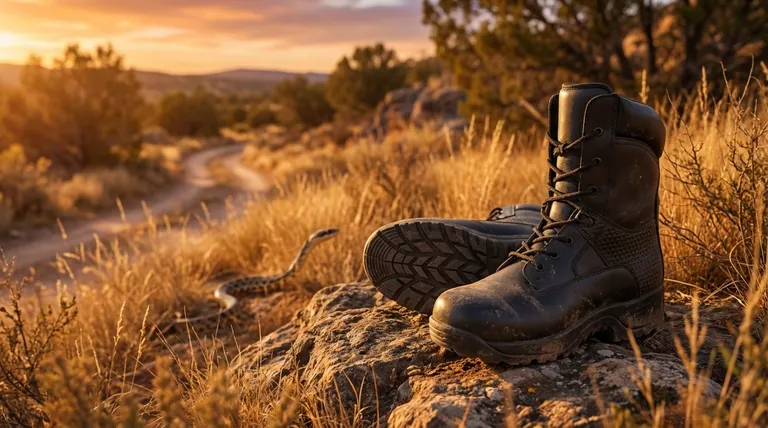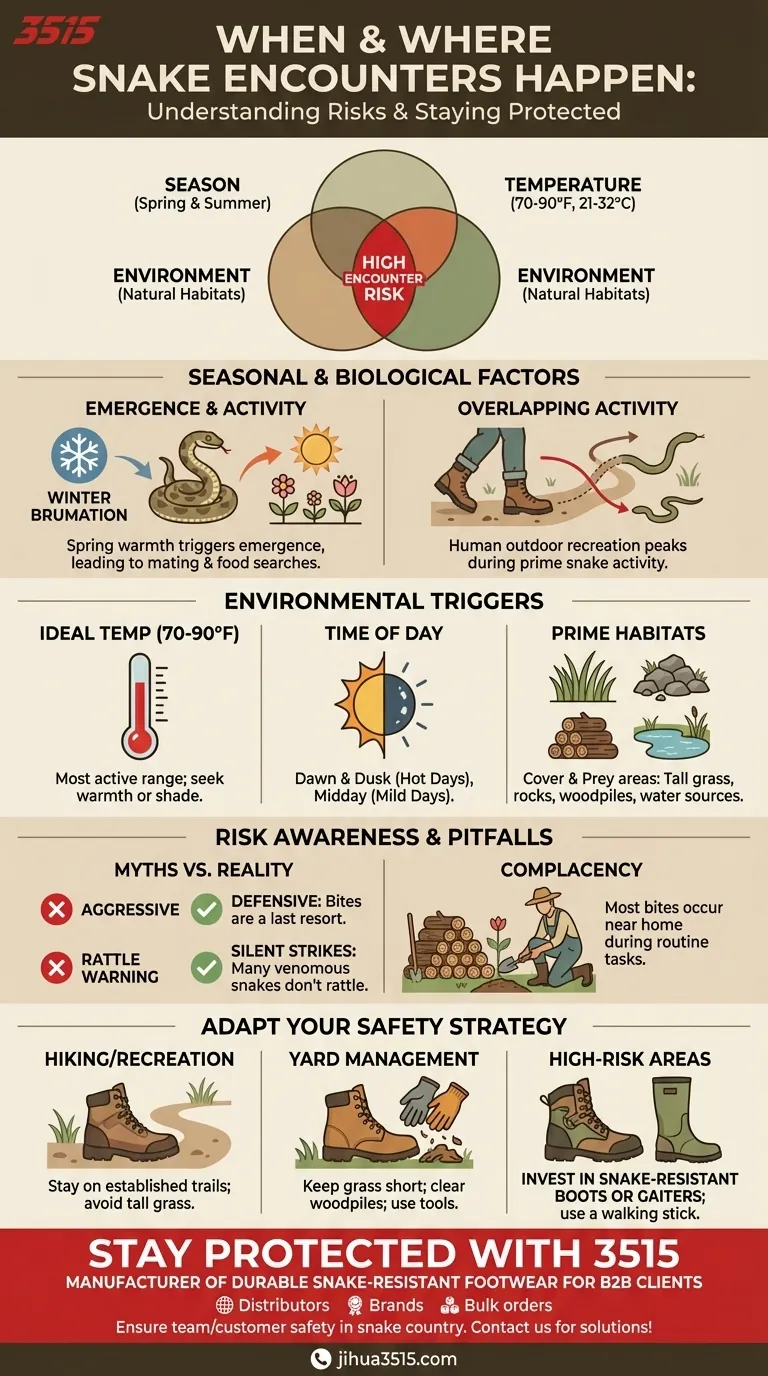Statistically, you are most likely to encounter a snake while wearing boots during the warmer months of spring and summer. This is when snakes emerge from their winter dormancy and become highly active, often in the very terrains—like woods, tall grass, and rocky areas—where protective footwear is essential.
The greatest risk of a snake encounter is not determined by a single factor, but by the intersection of three conditions: the right season (spring/summer), the right temperature (warm), and the right environment (natural, undisturbed habitats).

The Seasonal Factor: Why Warm Months Increase Encounters
Snakes are ectothermic, meaning their body temperature and activity levels are dictated by their surroundings. This makes seasonal changes the single biggest predictor of their behavior.
Emerging from Winter Dormancy
During the cold months, snakes enter a state of brumation (the reptilian equivalent of hibernation). As temperatures consistently rise in the spring, they emerge to fulfill critical needs.
The Search for Mates and Food
After a long period of inactivity, snakes are driven to find food and reproduce. This leads to significantly more movement as they travel through their habitats, increasing the chances of crossing paths with people.
Overlapping Human Activity
Spring and summer are also when people are most active outdoors. Hiking, hunting, camping, and land management work all place you directly into prime snake territory at the exact time snakes are most active.
Beyond the Calendar: Key Environmental Triggers
While season is the primary guide, specific environmental conditions provide a more precise understanding of when and where you might find snakes.
Temperature is the Real Driver
A snake's ideal active temperature range is typically between 70-90°F (21-32°C). On milder spring or fall days, they are more likely to be out during the warmest part of the day, often sunning themselves on rocks or trails to absorb heat.
Time of Day Matters
In the intense heat of summer, many snakes become crepuscular, meaning they are most active during the cooler hours of dawn and dusk. In hot climates, they will often seek shelter from the midday sun, just as you might.
Prime Snake Habitats
Snakes prefer areas that offer both cover from predators and access to prey. Wearing boots is common in these exact locations:
- Tall grass and brushy fields
- Rocky outcrops and crevices
- Woodpiles, logs, and fallen debris
- Near water sources like creeks and ponds
Understanding the Risks and Common Pitfalls
Awareness is your best defense. Understanding snake behavior helps you avoid creating a situation that feels threatening to the animal.
The Myth of Aggression
The vast majority of snakes are not aggressive; they are defensive. Bites are almost always a last-resort reaction to being startled, cornered, or directly threatened. Given a choice, a snake will almost always choose to flee.
"I Didn't Hear a Rattle"
Never assume a snake is non-venomous because you don't hear a warning. Many venomous species in North America, like the Copperhead and Cottonmouth, do not have rattles. Furthermore, even rattlesnakes may not rattle before striking if they are taken by surprise.
Complacency in Familiar Areas
Most snakebites occur close to home. People performing routine yard work or walking on their own property can become complacent. Always remain vigilant when moving woodpiles, clearing brush, or reaching into areas you cannot see.
Making the Right Choice for Your Safety
Your strategy for avoiding encounters should adapt to your specific activity. The core principles remain the same: be aware of your surroundings and give snakes a wide berth.
- If your primary focus is hiking or recreation: Stay on clear, established trails and avoid walking through tall grass or thick underbrush where you can't see your feet.
- If your primary focus is yard or land management: Keep grass mown short, remove piles of wood or debris, and wear thick gloves when moving materials where a snake could be hiding.
- If your primary focus is maximum protection in high-risk areas: Invest in purpose-built snake boots or snake gaiters and always use a walking stick to probe ahead of you in thick brush.
Ultimately, situational awareness and a healthy respect for wildlife are your most effective tools for staying safe.
Summary Table:
| Key Factor | High-Risk Period/Condition | Why It Matters |
|---|---|---|
| Season | Spring & Summer | Snakes emerge from brumation and are highly active. |
| Temperature | 70-90°F (21-32°C) | Ideal range for snake activity; they seek warmth or shade. |
| Time of Day | Dawn & Dusk (Summer) / Midday (Milder Days) | Snakes adjust activity to avoid extreme temperatures. |
| Environment | Tall Grass, Rocky Areas, Woodpiles, Near Water | These habitats offer cover and prey, increasing encounter risk. |
Don't Let Your Next Outdoor Adventure Turn Risky—Stay Protected with 3515!
As a large-scale manufacturer, 3515 produces a comprehensive range of durable, snake-resistant boots and footwear for distributors, brand owners, and bulk clients. Our production capabilities ensure you get high-quality protection tailored for hiking, land management, or high-risk terrains.
📞 Contact us today to explore our safety footwear solutions and keep your team or customers safe in snake country!
Visual Guide

Related Products
- Premium Grain Leather Safety Boots for Bulk Supply
- Customizable Anti-Smash Safety Boots for Wholesale & Private Label Manufacturing
- Premium Wholesale Waterproof Safety Boots High Performance Protection for Industrial Markets
- Premium Wholesale Wheat Nubuck Safety Boot with Rapid Lacing System
- Custom Wholesale Leather Safety Boots Direct Factory Manufacturing
People Also Ask
- What is a safety-toe in a boot? Your Guide to Choosing the Right Protection
- Do moc toe boots have steel toe? Get Durable, Safety-Compliant Footwear
- Is safety-toe as good as steel toe? Choose the Right Protection for Your Job
- Is there a downside to steel toe boots? Weighing Protection Against Daily Comfort
- What boots do they wear on oil rigs? Essential Safety Footwear for Harsh Conditions



















